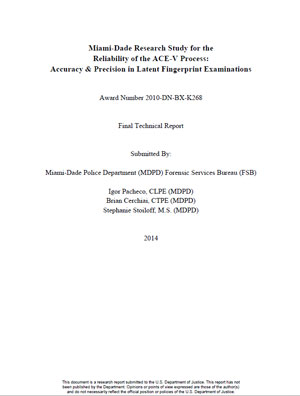Miami-Dade Research Study for the Reliability of the ACE-V Process: Accuracy and Precision in Latent Fingerprint Examinations
Igor Pacheco
Brian Cerchiai
Stephanie Stoiloff
Abstract:
This research reports on an empirical study that evaluated the reliability of the Analysis, Comparison, and Evaluation (ACE) and Analysis, Comparison, Evaluation, and Verification (ACE-V) methodologies in latent fingerprint examinations. The participants’ performance was measured in terms of accuracy and precision, and was evaluated under both unbiased and biased conditions. Accuracy was measured in terms of the participant’s ability to correctly identify or exclude a latent print to a known source(s) and precision was measured in terms of the participant’s ability to reproduce and repeat the same conclusion. Reproducibility is defined as the ability of multiple participants to examine the same latent print and reach the same conclusion independently, while repeatability is defined as the participant’s ability to provide the same conclusion upon re-evaluation of the same latent print. For the purpose of this research, bias was defined as the ability of a participant to reproduce and repeat a conclusion when presented with two previous conclusions and asked to conduct a second verification.
The foundation of latent fingerprint identification is that friction ridge skin is unique and persistent. Through the examination of all of the qualitative and quantitative features available in friction ridge skin, impressions can be positively identified or excluded to the individual that produced it. This study reports the results of four categorical opinions: identification, exclusion, inconclusive, and no value decisions. In addition, sufficiency determinations and comparison decisions were evaluated based on a latent Strength of Value and Difficulty of Comparison rating scale that was designed for this research.
Tests were assembled using 80 latent prints with varying quantity and quality of information from ten known sources and were distributed to 109 latent print examiners across the United States. Participants had at least one year of latent print examination experience and employed the ACE methodology when comparing unknown latent prints to known sources. Responses from the participants yielded 5,963 sufficiency determinations, 4,536 ACE decisions, 532 ACE-V decisions, 1,311 repeatability decisions, 326 ACE decisions under biased conditions, and 333 repeatability decisions under biased conditions. This study took into account inconclusive responses in determining error rates and established a False Positive Rate (FPR) of 3.0% and False Negative Rate (FNR) of 7.5% for ACE examinations, as well as a FPR of 0.0% and FNR of 2.9% for ACE-V examinations. Participants were able to reproduce a correct identification 94.2% of the time and not reproduce an erroneous identification 100% of the time. Participants repeated their previous correct identifications 94.6% of the time and did not repeat their previous erroneous exclusions 93.1% of the time. Under biased conditions, participants were able to reproduce a correct identification 73.0% of the time and not reproduce an erroneous identification 96.5% of the time. Additionally, under biased conditions, participants repeated their previous correct identifications 93.2% of the time and did not repeat their previous erroneous exclusions 85.2% of the time.
This project was supported by Award No. 2010-DN-BX-K268 awarded by the National Institute of Justice, Office of Justice Programs, U.S. Department of Justice. The opinions, findings, and conclusions or recommendations expressed in this publication/program/exhibition are those of the authors and do not necessarily reflect those of the Department of Justice.
The Report:
Read/download the report (79 pages)
Read/download the report (79 pages)
Article posted February 2, 2015

